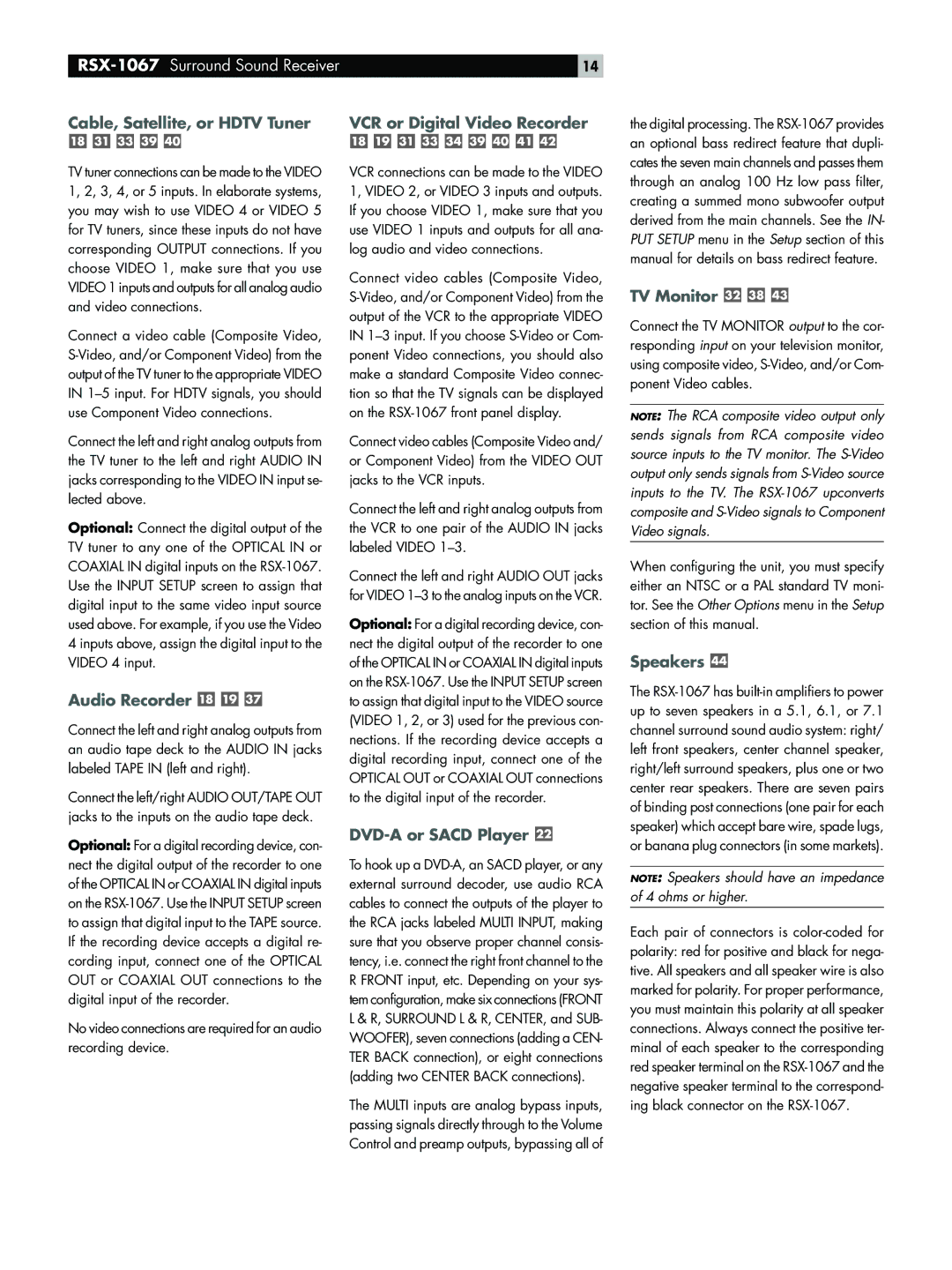RSX-1067Surround Sound Receiver
Cable, Satellite, or HDTV Tuner
TV tuner connections can be made to the VIDEO 1, 2, 3, 4, or 5 inputs. In elaborate systems, you may wish to use VIDEO 4 or VIDEO 5 for TV tuners, since these inputs do not have corresponding OUTPUT connections. If you choose VIDEO 1, make sure that you use VIDEO 1 inputs and outputs for all analog audio and video connections.
Connect a video cable (Composite Video, S-Video, and/or Component Video) from the output of the TV tuner to the appropriate VIDEO IN 1–5 input. For HDTV signals, you should use Component Video connections.
Connect the left and right analog outputs from the TV tuner to the left and right AUDIO IN jacks corresponding to the VIDEO IN input se- lected above.
Optional: Connect the digital output of the TV tuner to any one of the OPTICAL IN or COAXIAL IN digital inputs on the RSX-1067. Use the INPUT SETUP screen to assign that digital input to the same video input source used above. For example, if you use the Video 4 inputs above, assign the digital input to the VIDEO 4 input.
Audio Recorder 


Connect the left and right analog outputs from an audio tape deck to the AUDIO IN jacks labeled TAPE IN (left and right).
Connect the left/right AUDIO OUT/TAPE OUT jacks to the inputs on the audio tape deck.
Optional: For a digital recording device, con- nect the digital output of the recorder to one of the OPTICAL IN or COAXIAL IN digital inputs on the RSX-1067. Use the INPUT SETUP screen to assign that digital input to the TAPE source. If the recording device accepts a digital re- cording input, connect one of the OPTICAL OUT or COAXIAL OUT connections to the digital input of the recorder.
No video connections are required for an audio recording device.
14
VCR or Digital Video Recorder
VCR connections can be made to the VIDEO 1, VIDEO 2, or VIDEO 3 inputs and outputs. If you choose VIDEO 1, make sure that you use VIDEO 1 inputs and outputs for all ana- log audio and video connections.
Connect video cables (Composite Video, S-Video, and/or Component Video) from the output of the VCR to the appropriate VIDEO IN 1–3 input. If you choose S-Video or Com- ponent Video connections, you should also make a standard Composite Video connec- tion so that the TV signals can be displayed on the RSX-1067 front panel display.
Connect video cables (Composite Video and/ or Component Video) from the VIDEO OUT jacks to the VCR inputs.
Connect the left and right analog outputs from the VCR to one pair of the AUDIO IN jacks labeled VIDEO 1–3.
Connect the left and right AUDIO OUT jacks for VIDEO 1–3 to the analog inputs on the VCR.
Optional: For a digital recording device, con- nect the digital output of the recorder to one of the OPTICAL IN or COAXIAL IN digital inputs on the RSX-1067. Use the INPUT SETUP screen to assign that digital input to the VIDEO source (VIDEO 1, 2, or 3) used for the previous con- nections. If the recording device accepts a digital recording input, connect one of the OPTICAL OUT or COAXIAL OUT connections to the digital input of the recorder.
DVD-A or SACD Player 
To hook up a DVD-A, an SACD player, or any external surround decoder, use audio RCA cables to connect the outputs of the player to the RCA jacks labeled MULTI INPUT, making sure that you observe proper channel consis- tency, i.e. connect the right front channel to the R FRONT input, etc. Depending on your sys- tem configuration, make six connections (FRONT L & R, SURROUND L & R, CENTER, and SUB- WOOFER), seven connections (adding a CEN- TER BACK connection), or eight connections (adding two CENTER BACK connections).
The MULTI inputs are analog bypass inputs, passing signals directly through to the Volume Control and preamp outputs, bypassing all of
the digital processing. The RSX-1067 provides an optional bass redirect feature that dupli- cates the seven main channels and passes them through an analog 100 Hz low pass filter, creating a summed mono subwoofer output derived from the main channels. See the IN- PUT SETUP menu in the Setup section of this manual for details on bass redirect feature.
TV Monitor 


Connect the TV MONITOR output to the cor- responding input on your television monitor, using composite video, S-Video, and/or Com- ponent Video cables.
NOTE: The RCA composite video output only sends signals from RCA composite video source inputs to the TV monitor. The S-Video output only sends signals from S-Video source inputs to the TV. The RSX-1067 upconverts composite and S-Video signals to Component Video signals.
When configuring the unit, you must specify either an NTSC or a PAL standard TV moni- tor. See the Other Options menu in the Setup section of this manual.
Speakers 
The RSX-1067 has built-in amplifiers to power up to seven speakers in a 5.1, 6.1, or 7.1 channel surround sound audio system: right/ left front speakers, center channel speaker, right/left surround speakers, plus one or two center rear speakers. There are seven pairs of binding post connections (one pair for each speaker) which accept bare wire, spade lugs, or banana plug connectors (in some markets).
NOTE: Speakers should have an impedance of 4 ohms or higher.
Each pair of connectors is color-coded for polarity: red for positive and black for nega- tive. All speakers and all speaker wire is also marked for polarity. For proper performance, you must maintain this polarity at all speaker connections. Always connect the positive ter- minal of each speaker to the corresponding red speaker terminal on the RSX-1067 and the negative speaker terminal to the correspond- ing black connector on the RSX-1067.









